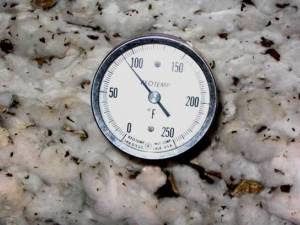 |
| Rapid rise in module temperatures means moisture issues. |
Only four days after fall temperatures climbed into the
mid-90s, the skies turn dark and cloudy, dropping a quarter inch of rain on the
defoliated cotton fields last Monday. The wet fiber suddenly idled the cotton
harvesters. Growers had to wait several
days for the cotton to dry out before resuming harvest activities late last
week.
If growers pick cotton that has high moisture content,
there’s a strong chance that mildew will develops in harvested fiber. Wet
cotton also impacts the cotton quality during the ginning process.
I found some interesting articles about monitoring
moisture during the cotton harvest and moisture
management and the ginning process by the North Carolina Cooperative
Extension Service and the USDA.
The late October rain we experience is pretty normal for the
San Joaquin Valley. If you look at the National Weather Service’s historical
statistics, we usually get about two-tenths to a quarter inch of rain around
the 20th of the month. What make it unusual is the weather seemed to
turn on a dime.
In fact, on Thursday, October 18 (just a day before our
annual Cotton Farm Tour), the daily high temperature climbed to 95 degrees,
tying the record high set in 1905. By the following Monday, the rains came and
temperatures plummeted with the daily high reaching only 63 degrees, just a
degree off the all-time record for lowest maximum temperature that day. The
good news: the rain didn’t knock any cotton to the ground.
Warmer temperatures over the past weekend and clear weather
forecast for the rest of this week bodes well for growers. This should allow
them to make up for lost time and move forward with the harvest. I anticipate
this year’s harvest will continue through November with the late-season pima
variety fully picked after Thanksgiving.
 |
| Rain added moisture to cotton in the fields. |

No comments:
Post a Comment